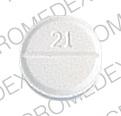Hygroton Side Effects
Generic name: chlorthalidone
Medically reviewed by Drugs.com. Last updated on May 13, 2023.
Note: This document contains side effect information about chlorthalidone. Some dosage forms listed on this page may not apply to the brand name Hygroton.
Applies to chlorthalidone: oral tablet.
Serious side effects of Hygroton
Along with its needed effects, chlorthalidone (the active ingredient contained in Hygroton) may cause some unwanted effects. Although not all of these side effects may occur, if they do occur they may need medical attention.
Check with your doctor immediately if any of the following side effects occur while taking chlorthalidone:
Incidence not known
- Abdominal or stomach pain
- black, tarry stools
- bleeding gums
- blistering, peeling, or loosening of the skin
- bloating
- blood in the urine or stools
- blurred vision
- burning, crawling, itching, numbness, prickling, "pins and needles", or tingling feelings
- chest pain
- chills
- clay-colored stools
- cold sweats
- confusion
- cough or hoarseness
- coughing up blood
- darkened urine
- diarrhea
- difficulty having a bowel movement (stool)
- dizziness, faintness, or lightheadedness when getting up suddenly from a lying or sitting position
- dry mouth
- fast heartbeat
- fever
- flushed, dry skin
- fruit-like breath odor
- general feeling of tiredness or weakness
- headache
- increased hunger
- increased thirst
- increased urination
- indigestion
- itching or skin rash
- joint pain, stiffness, or swelling
- loss of appetite
- lower back or side pain
- nausea
- pain in the joints or muscles
- painful or difficult urination
- pains in the stomach, side, or abdomen, possibly radiating to the back
- pinpoint red spots on the skin
- red, irritated eyes
- red skin lesions, often with a purple center
- redness, soreness or itching skin
- sore throat
- sores, ulcers, or white spots on the lips or in the mouth
- sores, welting, or blisters
- sugar in the urine
- sweating
- swelling of the feet or lower legs
- swollen glands
- tightness in the chest
- troubled breathing
- unpleasant breath odor
- unusual bleeding or bruising
- unusual tiredness or weakness
- unusual weight loss
- vomiting
- vomiting of blood
- weight loss
- yellow eyes or skin
Other side effects of Hygroton
Some side effects of chlorthalidone may occur that usually do not need medical attention. These side effects may go away during treatment as your body adjusts to the medicine. Also, your health care professional may be able to tell you about ways to prevent or reduce some of these side effects.
Check with your health care professional if any of the following side effects continue or are bothersome or if you have any questions about them:
Incidence not known
- Cramping
- decreased interest in sexual intercourse
- feeling of constant movement of self or surroundings
- hives
- inability to have or keep an erection
- increased sensitivity of the skin to sunlight
- loss in sexual ability, desire, drive, or performance
- muscle spasm
- redness or other discoloration of the skin
- restlessness
- sensation of spinning
- severe sunburn
- weakness
For Healthcare Professionals
Applies to chlorthalidone: oral tablet.
Cardiovascular
Common (1% to 10%): Postural hypotension
Rare (less than 0.1%): Cardiac arrhythmias[Ref]
Dermatologic
Common (1% to 10%): Urticaria, rash
Rare (less than 0.1%): Photosensitivity
Frequency not reported: Purpura, necrotizing angiitis (vasculitis, cutaneous vasculitis), Lyell's syndrome (toxic epidermal necrolysis)[Ref]
Gastrointestinal
Common (1% to 10%): GI discomfort, anorexia
Rare (0.01% to 0.1%): Nausea, vomiting, upper abdominal pain, constipation, diarrhea
Very rare (less than 0.01%): Pancreatitis
Frequency not reported: Cramping[Ref]
Genitourinary
Common (1% to 10%): Impotence
Frequency not reported: Glycosuria[Ref]
Hematologic
Rare (less than 0.1%): Thrombocytopenia, leucopenia, agranulocytosis
eosinophilia
Frequency not reported: Aplastic anemia[Ref]
Metabolic
Very common (10% or more): Hypokalemia, hyperuricemia, hyperlipidemia
Common (1% to 10%): Hyponatremia, hypomagnesemia, hyperglycemia
Uncommon (0.1% to 1%): Gout
Rare (0.01% to 0.1%): Hypercalcemia, inadequate control of diabetes mellitus
Very rare (less than 0.01%): Hypochloremic alkalosis[Ref]
Hepatic
Rare (less than 0.1%): Intrahepatic cholestasis or jaundice[Ref]
Hypersensitivity
Hypersensitivity reactions usually involve the skin (see DERMATOLOGIC).[Ref]
Musculoskeletal
Frequency not reported: Muscle spasm[Ref]
Nervous system
Common (1% to 10%): Dizziness
Rare (less than 0.1%): Paresthesia, headache
Frequency not reported: Vertigo[Ref]
Other
Frequency not reported: Vertigo, weakness[Ref]
Ocular
Rare (less than 0.1%): Visual impairment
Frequency not reported: Xanthopsia[Ref]
Psychiatric
Frequency not reported: Restlessness[Ref]
Respiratory
Very rare (less than 0.01%): Noncardiogenic pulmonary edema[Ref]
Frequently asked questions
More about Hygroton (chlorthalidone)
- Check interactions
- Compare alternatives
- Reviews (2)
- Drug images
- Side effects
- Dosage information
- During pregnancy
- Drug class: thiazide diuretics
- Breastfeeding
Patient resources
Other brands
Professional resources
Other brands
Related treatment guides
References
1. Cerner Multum, Inc. UK Summary of Product Characteristics.
2. Cerner Multum, Inc. Australian Product Information.
3. Product Information. Chlorthalidone (chlorthalidone). Sun Pharmaceutical Industries. 2016.
Further information
Always consult your healthcare provider to ensure the information displayed on this page applies to your personal circumstances.
Some side effects may not be reported. You may report them to the FDA.

